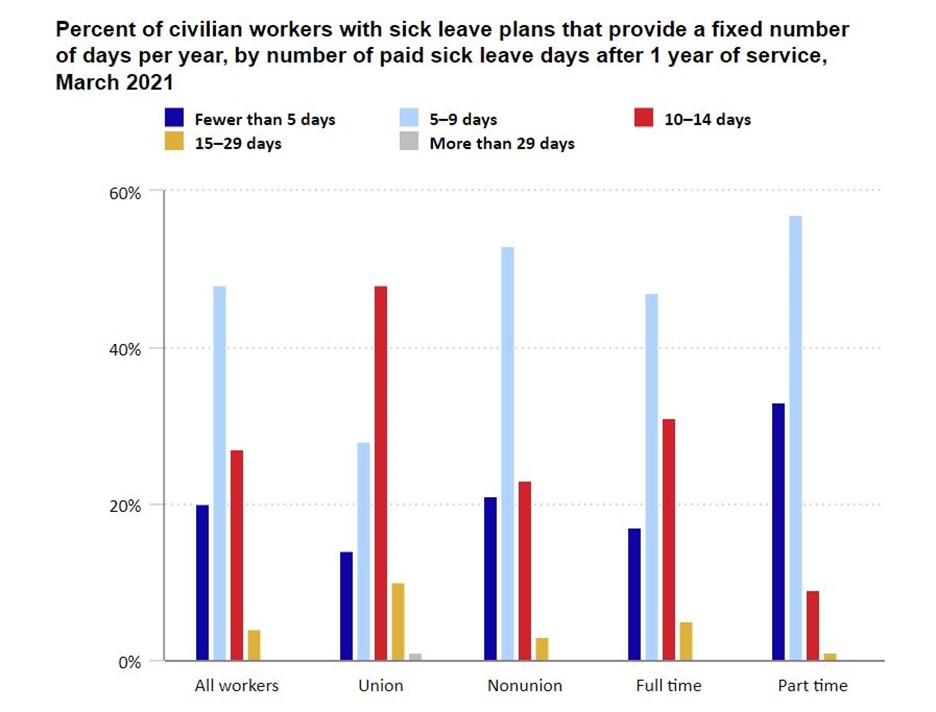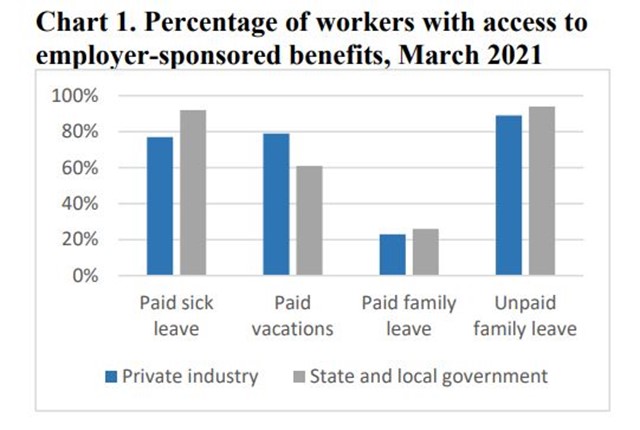
Here's what you need to know about the average number of sick days in the U.S.:
- Federal, state and/or local governments may issue sick leave mandates in response to public emergencies.
- Your sick leave policy needs to state who is an eligible family member.
- To arrive at the most appropriate number of sick days, you will need to consider other factors, including applicable federal, state and local laws.
The vast majority of employers in the United States offer paid time off, including sick leave. So, the question is not necessarily whether you provide sick leave but rather how much. If you don’t offer enough sick days, it can hurt your employee attraction and retention rates. But if you provide too many sick days, it could erode your bottom line.
Various factors influence how many sick days an employer should provide, including applicable sick leave laws. That said, knowing the estimated average number of sick days others give or receive is a good place to start.
What is the average number of sick days for civilian workers?
Civilian workers include all private-sector employees and individuals employed by state and local governments. To determine their average number of sick days, we examined the most recent data from the U.S. Bureau of Labor Statistics (BLS).
According to the BLS, in March 2023, 80 percent of U.S. civilian workers had access to paid sick leave. BLS found that in March 2021, per the latest published report we found on this information,:
- 69 percent received a fixed number of paid sick days.
- 29 percent received paid sick leave as part of a consolidated leave plan (e.g., a PTO bank).
- Two percent% received paid sick days as needed.
Be clear about what constitutes "sick leave" to reduce misunderstandings and confusion among your employees.
In terms of average sick leave per year, the average number of paid sick days per year U.S.A. civilian workers could access broke down as follows:
- Eight days per year for full-time workers.
- Six days per year for part-time workers.
- Eight days per year for workers who received a fixed number of paid sick days after one year of service.
- 10 days per year for union workers, after one year of service.
- Seven days per year for nonunion workers, after one year of service.

How many private-sector employees receive sick days?
Per the BLS, 78 percent of private sector workers had access to paid sick leave in March 2023. Among those, 87 percent of full-time and 51 percent of part-time workers had access to paid sick leave.
Of major occupation groups, paid sick leave was most common among the following:
- Management, business and financial occupations (96 percent).
- Management, professional and related occupations (93 percent).
- Professional and related occupations (91 percent).
- Office and administrative support occupations (87 percent).
- Installation, maintenance and repair occupations (80 percent).
- Protective services occupations (68 percent).
- Sales and office occupations (80 percent).
The chart below shows how many workers have access to employer-sponsored benefits, including paid sick leave.

Source: U.S. Bureau of Labor Statistics
Notably, a large percentage of private-sector workers also have access to unpaid family leave, which often includes sick leave.
How many U.S. employers offer paid sick leave?
The Society for Human Resource Management’s 2023 SHRM Employee Benefits Survey drew responses from more than 4,200 participants from organizations nationwide ranging in size and industry. Accordingly, the survey concluded:
- 95 percent of employers offered paid sick leave.
- 70 percent offered a PTO system that combines both vacation and sick leave.
- 19 percent offered paid mental health days, separate from regular sick leave.
What is the average number of sick days taken?
To determine this, we referred to rolling surveys conducted by Statista. Note that the Statista surveys date back to 2020 and cover sick days taken by adults from work or school/university over the past 12 months.
The surveys found:
- Among approximately 80 percent of U.S. adults who worked or studied, nearly 25 percent had not taken any sick days between mid-2022 and mid-2023.
- Of those who reported taking sick days, two to three days were most common.
- Nine percent of respondents reported taking 11-20 or more.
How many sick days per year should you provide?
This question is more complicated than it appears due to the many variables involved. Employers can’t depend on subjective opinions or trends that attempt to answer how many sick days a year is normal or how many sick days does the average person take in a year. And while the BLS’ analysis is a reliable benchmark, it would also be a mistake to rely solely on it. Beyond trying to determine how many sick days does the average American take, consider the factors below when deciding how many sick days to offer.
Definition of sick leave, including its purpose
Be clear about what constitutes “sick leave” and “sick days” to reduce misunderstandings and confusion among your employees. Defining the purpose of sick leave overall also makes it easier to pinpoint how many days you should provide.
Generally, employees can take sick leave to recuperate from their own injury or illness or to care for a sick family member. In your sick leave policy, state who is an eligible family member. Typically, this includes children, spouses and registered domestic partners.
State and local paid sick leave laws
Depending on where your employees work, you may be legally required to offer paid sick leave.
- Arizona - State Law
- California - State and Local Laws
- Colorado - State Law
- Connecticut - State Law
- Illinois - Local Laws
- Maine - State Law
- Maryland - State and Local Laws
- Michigan - State Law
- Minnesota - Local Laws
- Nevada - State Law
- New Jersey - State Law
- New Mexico - State Law
- New York - State and Local Laws
- Oregon - State Law
- Pennsylvania - Local Laws
- Rhode Island - State Law
- Vermont - State Law
- Washington - State and Local Laws
- Washington, D.C. - District Law
Jurisdictions with sick leave laws
Always consult a reliable source for jurisdictions with state and/or local paid sick leave laws. If your jurisdiction requires paid sick leave, you can offer more than the mandated amount, but not less.
Federal law
Federal law does not require private-sector employers to offer paid sick leave. However, the Family and Medical Leave Act (FMLA) requires covered employers to grant qualified unpaid leave, which includes sick time.
Under the FMLA, employers with 50 or more employees must generally offer eligible employees up to 12 weeks of unpaid, job-protected leave in a 12-month period. The FMLA covers eligible employees and their immediate family members.
State family and medical leave programs
Although these programs are conceptually similar to the FMLA, they are operated by the state government. Therefore, program details vary by jurisdiction. Depending on your location, you may need to offer paid or unpaid state family and medical leave, which includes sick time.
See “The Definitive List of State Family and Medical Leave Programs” for more information, including how much sick leave employers may need to offer.
Emergency sick leave mandates
The federal, state and/or local governments may issue sick leave mandates in response to public emergencies. A perfect example is the COVID-19 pandemic. These mandates typically state the minimum paid or unpaid sick leave employers should offer.
When deciding how many paid sick days to offer, aim for a "sweet spot" that allows you to provide a competitive number without harming your profit margins.
Budget considerations
When deciding how many paid sick days to offer, aim for a “sweet spot” that allows you to provide a competitive number without harming your profit margins. Also, keep in mind applicable legal requirements.
While unpaid sick leave doesn’t directly cost you anything, you still need to cap the number of unpaid days employees can take. Otherwise, it can cost you in indirect ways, such as staffing shortages and disruptions in productivity.
In addition to the above factors, consider:
- Your workplace trends in terms of average times a person calls in sick, why and how it impacts your business.
- How sick days are offered, such as separately or as part of a consolidated leave plan.
- Your employees’ needs, including how much sick time they likely require based on their personal circumstances.
Examine the full picture
In short, to arrive at the most appropriate number of unpaid or paid sick days to offer, think past the average number of sick days per year others report. You will need to factor in your organization’s needs and total resources and any applicable federal, state and local laws.






